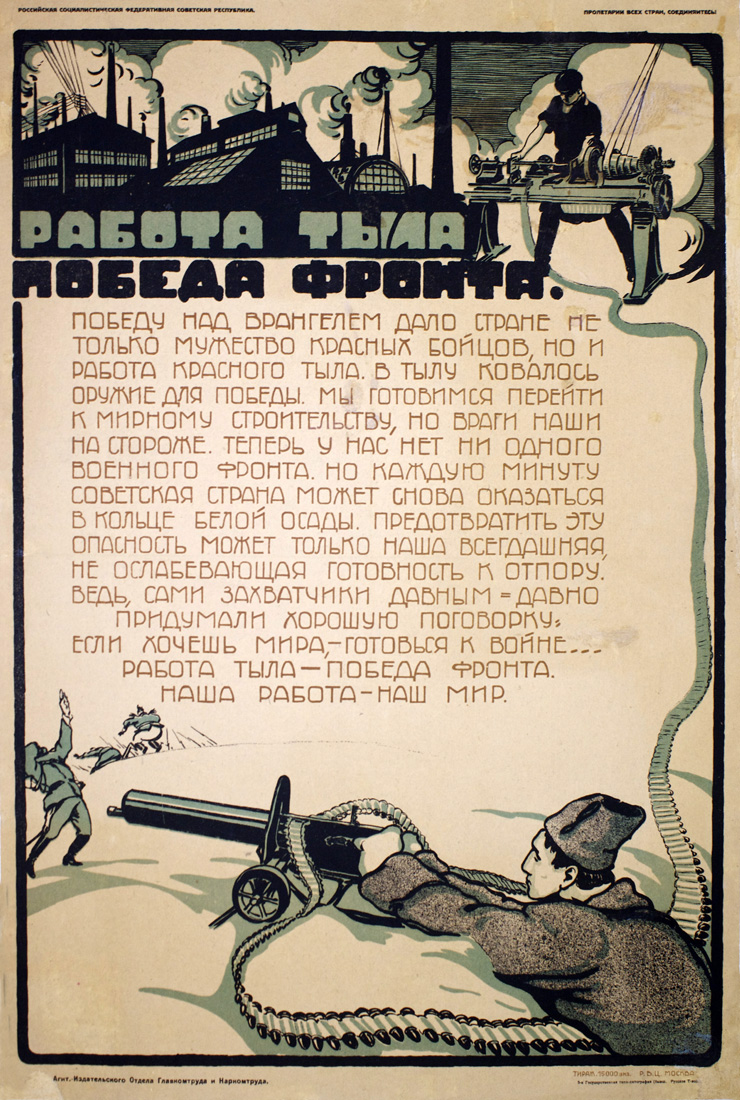
El trabajo de la retaguardia es la victoria en el frente. ““Nuestro país venció a Wránguel no solo por la valentía de los soldados rojos sino también por el trabajo de la retaguardia roja.” [Traducción parcial]
Número de Cartel: PP 358
Información sobre el cartel: El barón Piotr Nikoláievich Wránguel (1878-1928) era un oficial ruso del Ejército Imperial y un comandante general del Ejército Blanco antibolchevique en el Sur de Rusia. El Ejército Rojo de los bolcheviques derrotó a Wránguel y a sus hombres en 1920.
Tamaño: 30.5x22
Tipo de cartel: Litografía
Fecha de publicación: c. 1920
Información técnica: RVTs (Passed by Military Censor), Moscow.
Ediciones: 15,000
Fuentes: Soviet Posters of the era of the Civil War 1918-1921 by B.S. Butnik-Siverskii (1960), page 304, poster 1609
En el catologo: PP 358 Civil War
Artista: Artist Unknown — неизвестный художник
The artist's name on the poster is not indicated. By assigning Artist Unknown to a poster it also could mean the artist used a chop mark whereby no signature is seen thus rendering the artist's identity anonymous.
Leer más...
Imprenta: 5th State Typolithography Workshop, Moscow (formerly Russian Partnership) — 5-я государственный типо-литография, (бывш. Русское товарищество)
Located in the Chistye Prudy neighborhood at 14 Myl'nikov Lane (a.k.a. Zhukovskii Street); the 5th State Typolithography Workshop was the Russian Partnership prior to its nationalization. Around 1922 the printer was placed under the Mospoligraf printing trust during a period of consolidation that occurred in the Moscow printing industry. With a staff of over two thousand, Mospoligraf oversaw a myriad of printers under local sections. Subsequently, Mospoligraf was the second-largest printing trust in Moscow outside ...
Leer más...
Editorial: Glavkomtrud and Narkomtrud (Main Committee on Universal Compulsory Labor and Public Commissariat of Labor) — Главкомтруда и Наркомтруда
Glavkomtrud (Main Committee on Universal Compulsory Labor) was established in 1920 during the Russian Civil War to mobilize labor troops to help win the war for the Bolsheviks and rebuild infrastructure. It was divided into provincial branches called Кomtruds (Labor Committees). Glavkomtrud and the Komtruds were both interdepartmental organizations devised for coordinating mandatory labor conscription. The People’s Commissariat for Labor (Narkomtrud) collected data concerning the number of eligible workers for conscription. Labor mobilization spanned a v...
Leer más...